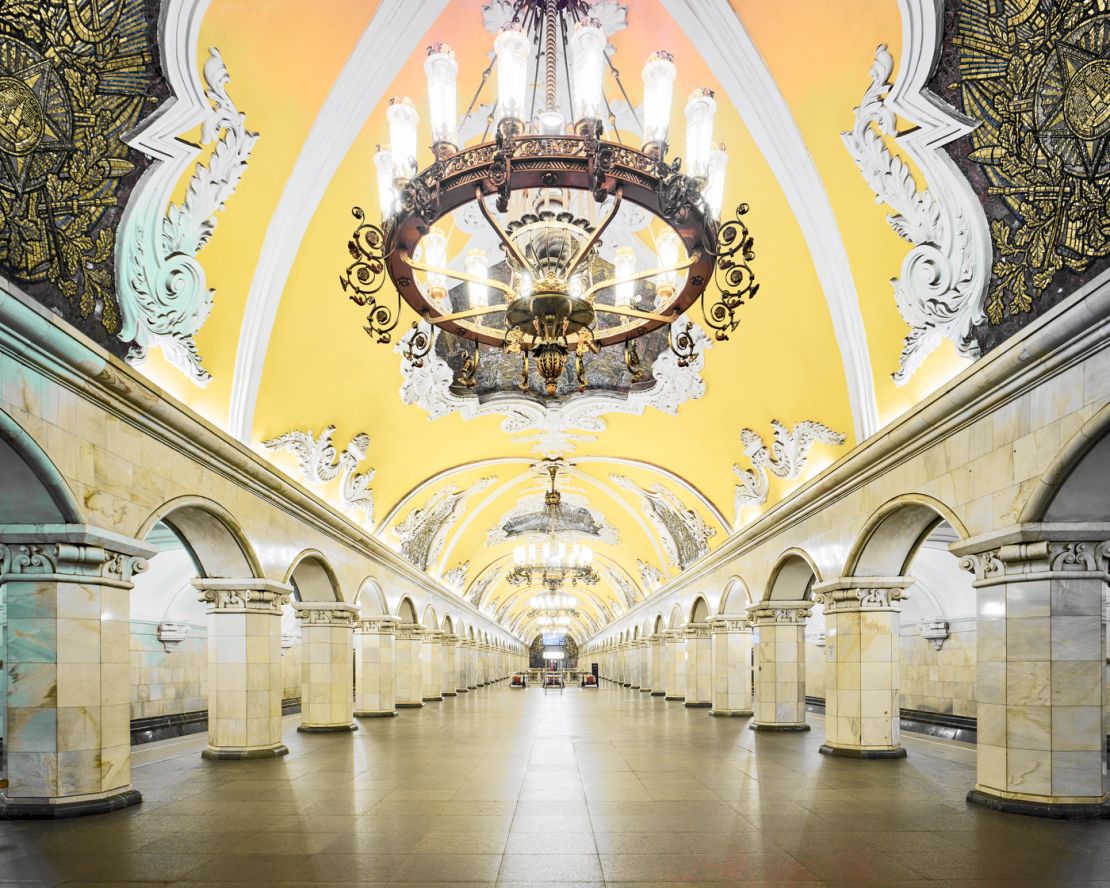Story highlights
Photographer David Burdeny captured the first study of Moscow's historic metro stations
Stations feature stained glass, crystal chandeliers, and gilded mosaics
Baroque, Art Deco and Futurist architecture are represented, among other styles
For many commuters around the world, a subway journey means speeding from one drab station to the next, surrounded by too many uncomfortable, impatient bodies. But on the Moscow Metro, taking the subway is akin to walking through a national heritage site.
Depending on where you get off, you’ll receive a crash course in such diverse architectural movements as Baroque, Art Deco or Futurism, and face stained glass windows, marble columns, crystal chandeliers, gilded mosaics and painted scenes from Russian history.
Read: Capturing the vast beauty of the Arctic with just pastel on paper
“They’re just these extraordinarily beautiful places that are unlike any metro station I’d ever seen,” says Vancouver-based photographer David Burdeny.
Palaces for the people
In 2014, Burdeny traveled to Russia to produce the first formal study of these architectural wonders for his series Russia: A Bright Future. In all, he photographed 20 of the most beautiful stations.
15 of the world's most exquisite libraries
Burdeny, who himself has a master’s degree in architecture as well as a bachelor’s in interior design, first found out about Moscow’s metro stations while working on a separate series on Italian palaces and theaters. He was struck by the use of opulent architecture to elevate an otherwise drab destination into a work of art.
Read: The ‘Golden Age’ of Arab cinema resurrected in a Beirut basement
“Typically, a metro station is a pedestrian place which serves as a utilitarian device to get you from one place to another. But these were extraordinarily built and constructed, [with] a whole architectural narrative built into them.”
In many ways, Moscow owes its elaborate undergrounds to dictator Joseph Stalin. Russia’s first metro system, part of his first Five-Year Plan to rapidly industrialize the Soviet Union in the 1920s and 30s, was meant to show its citizens – and the world – the power and possibilities the Communist Party presented.
Burdeny had originally planned to focus on Russian stations more generally, taking photos of examples in both St Petersburg and Moscow.
Read: A rare glimpse inside North Korea’s “socialist fairyland”
“But when I saw the ones in Moscow, they just completely blew away the St Petersburg stations,” he says, citing the Baroque Komsomolskaya Metro Station as the one that best “reinforced the idea that these were palaces for the people.”
Challenges on the ground
Shooting in the subway sounds simple, but it was not without challenges. For one, Burdeny had to figure out a way to access them between 12:30 am and 5:30 am, when the stations were closed.
He spent a year trying to secure permissions to shoot independently before hiring a Russian producer to help him secure the necessary permits and liaise with local authorities, which took another six months.

And while it was easy enough to enter most stations, some proved challenging.
“There was one time that we got there, and [the security guard] had an issue with me being from North America, and wanted to know if Canada was involved in the sanctions against them,” he recalls. “Sometimes it was easy to get in, but then there was the odd person who was running the place who really didn’t want to deal with me.”
An impossible goal
Looking back at his study, Burdeny finds it difficult to choose a favorite image. Each brings back a specific story or experience.
In the end, he settles on the opulent white Arbatskaya Metro Station, whose barrel vaulted arches he finds the most spatially beautiful. But it also represents a challenge he’s not sure he was able to overcome: conveying the sheer immensity of the spaces. The Arbatskaya platform, for example, stretches 820 feet.
Read: Eritrea’s playground of futurist architecture
“Some of them are quite long, and the proportions are really elegant,” he says. “The scale doesn’t really translate that well once you see the image, but when you enter them, they’re just so completely grand.”



!["Typically, a metro station is a pedestrian place which serves as a utilitarian device to get you from one place to another. But these were extraordinarily built and constructed, [with] a whole architectural narrative built into them," Burdeny said.](https://media.cnn.com/api/v1/images/stellar/prod/160316154848-moscow-metro-stations-david-burdeny-belorusskaya.jpg?q=w_1400,h_1120,x_0,y_0,c_fill/h_447)























